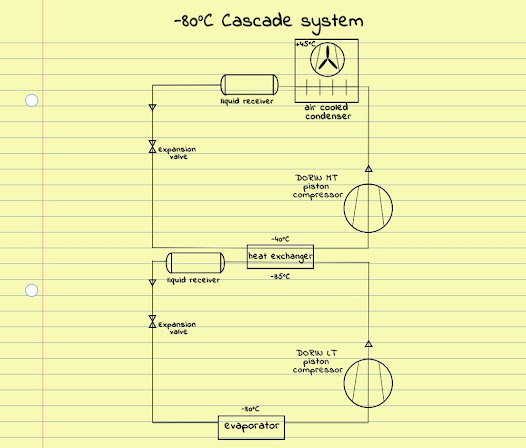Advantages of using an inverter on refrigeration systems
Using an inverter with a refrigeration compressor can grant several advantages:
- Continuous regulation of compressor’s cooling capacity
- Drastic reduction of temperature’s variations in the
cold room, better product’s conservation, optimized heat exchange
- Stable operating pressures and higher Tevap. ↔ better system’s COP
- Optimization of control logics of rack units and its adaptability to system’s load avoiding useless and expensive start-stop cycles
- Improved system’s efficiency at partial load. Estimated 20-30% energy savings, compared to on-off regulation
- Relevant reduction of starting currents
- Compared to a normal current absorption at start-up equal to 5 - 8 times nominal current, inverter limits the maximum current at start-up to the nominal current value eliminating stresses for the motor/compressor for the whole system
- Reduced risk of liquid flow back at start-up, thanks to the soft-starting
- Reduced noise especially during nighttime when cooling required is lower than during daytime
- Possibility to operate at trans-synchronous speed with
an increase of cooling capacity of the compressor useful to cover peaks of
cooling capacity request. This means that it is possible to select smaller compressor.
Point of care
Electrical Aspects
To maintain the characteristics of the motor and ensure a constant torque at the shaft, it is necessary to ensure that the magnetic flux remains as close as possible to the design value.
Three-phase motors can be controlled in frequency guaranteeing the same performances as long as the V/f ratio is kept as constant as possible, in this way the magnetic flux in the motor is maintained in the values established by the manufacturer.
Voltage/frequency ratio (V/f=k)
If the inverter can increase the frequency maintaining the voltage/frequency ratio constant (V/f=constant) the current absorbed by the compressors will remain almost stable at the value indicated at 50 Hz and the variation of power requested will be compensated by the variation of the voltage out from the inverter
Operations with non-constant Voltage/frequency ratio (V/f≠k): under-voltage
When a 400/3/50 PWS motor is supplied by an inverter connected to a 400/3/50 supply voltage network and it is pushed to work above 50 Hz, the inverter cannot supply a higher voltage than the one available at the network, therefore it will increase the frequency maintaining the outlet voltage constant and the V/f ratio, that is 8 at 50 Hz, will reduce when the frequency will increase .
The increase of power requested by the motor will be then obtained with increasing the absorbed current.
The maximum allowable frequency for each compressor, within the general limits 30-70 Hz, can be calculated with the following formula:
Where:
I (50Hz, SST, SCT) is the absorbed current of the compressor at rated working condition
FLA: is the maximum operating current of the compressor indicated on compressor’s label.
a: is a coefficient which depends by the type of compressors
Use different motors than 400/3/50
If it is necessary to operate at higher frequency than Fmax calculated as above, it is possible to use different winding to increase Fmax.
If the compressor is equipped with a motor 230/3/50 and the inverter is connected to 400/3/50 power supply, it is possible to grant a V/f constant till 87 Hz. The design V/f is in this case 230/50 = 4,6 and the inverter can rise frequency up to 400/4,6 = 87 Hz.
This solution requires an inverter 1,7 times larger due to the higher current absorption of 230/3/50 motor.
A compromise is to use motors 400/3/60 so that the inverter can grant an Fmax value 20% higher than the standard 400/3/50 motor.
Mechanical Aspects
The performance of volumetric compressors is greatly influenced by the rotating speed. In particular:
- As the RPM increases, the refrigerant flow rate increases, therefore the pressure drops of the refrigerant through suction and discharge valves increase. The frictions also increase due to the higher speed.
-
As the RPM decreases, the pressure drops and friction
decrease, hence the sealing between suction and discharge during compression
worsens.
Reduced refrigerant flow reduces also the motor cooling and, if the operating conditions are critical, can head to motor protector tripping.
This increase in losses worsens the efficiency of the compressor at very high or very low speeds.
For compressors with oil pump also the performance of the oil pump needs to be considered.
Dorin compressor’s applications with Inverter
DORIN supports the use of compressors with Inverter since several years and approves operations with Variable Frequency Drive for all Dorin compressors.
General recommendations allow to operate almost all DORIN compressors between 30 Hz and 70 Hz (see specific information on official documentation), electrically the compressors can cover the full range or not depending by the type of motor, by the working conditions and by the type of power supply.
DORIN offers also a wide range of dedicated inverters for all its products as well as a special range of compressors, called HI range, equipped with special technical solutions that allow the compressors to operate smoothly in an extended frequency range, between 20 and 90 Hz.




